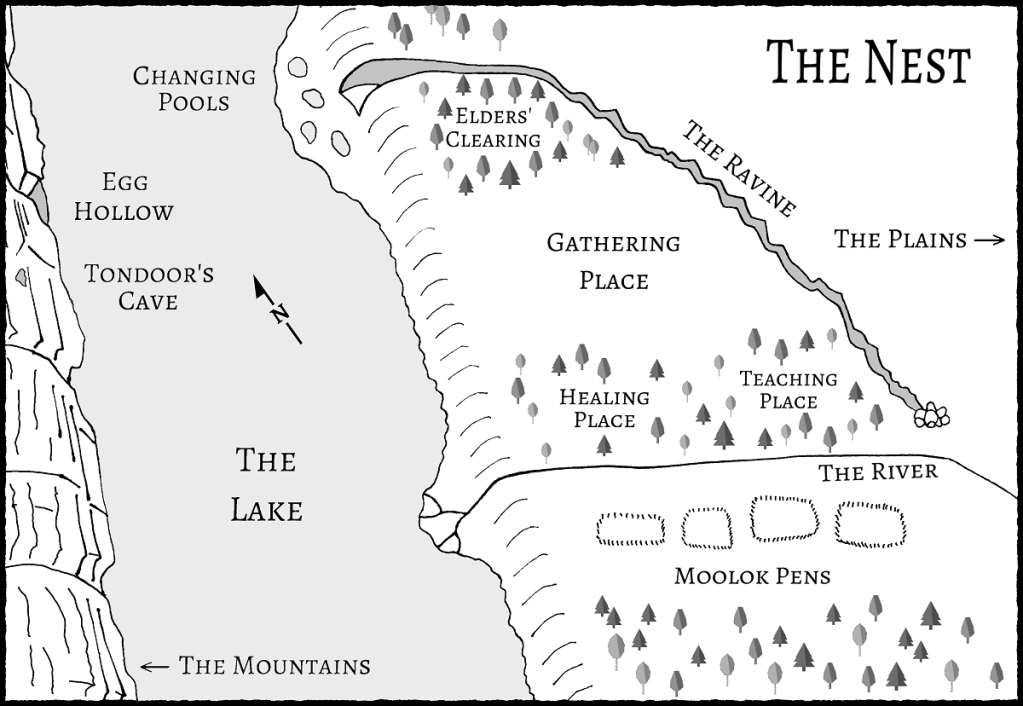
my nephew BR, out of a
single sheet of paper.
How cool is that!
This page talks about the planet and its geography, the anatomy and genetics of my dragons, how they communicate, and if you want them, stats for using these dragons in Pathfinder or 5th Edition.
My first novel Draco’s Child features one dragon. Dragon Planet: Kraamlok has a whole planet full of them!
Geography
The dragons in both books live on a planet in the Goldilocks Zone of a star called Sigma Draconis, or Alsafi, which is a dim orange star in what we see as the constellation Draco. We can’t see the star with the naked eye, but it is there. The planet may or may not be.
The Kraamlok dragons don’t know they are on a planet, so they just call it “the world”. The people in Draco’s Child call it “The Kettle” because Alsafi, the star they orbit, is a corruption of an Arabic world that means “cooking tripod.”
The planet as the dragons know it has six “corners”: the Desert or Wasteland (once called the Bountiful Land), the Plains, the Rocks (or mountains), the Bog, the Coast, and the Rainy Island. They are all in a northwest – southeast orientation, so I didn’t need to make a map, at least of the parts that we visit in the book.
The Nest is the “city” of the Dragons of the Plains. They are the only dragon culture in the book to have one. Most of the dragons spend most of their time out on the Plains herding their shaggy mooloks (think six-legged bison), and only the elders, hatchlings, hatchling minders, and a few storytellers, guards, healers and scouts live full-time in the Nest. All of the dragons return there for the various dragon ceremonies that mark their year.

Anatomy of the dragons
My dragons look a lot like velociraptors with wings, horns, no feathers, and without the killing claw because they are civilized and reasonable. Most of the time, anyway. Usually. If no one pushes them too far. You can see a diagram here.
They come in 7 natural colours plus grey, each with its own kind of strength or ability. The colours have a genetic hierarchy, which means that, for example, a Leaf dragon (green) mating with a Snow dragon (white), will normally have a Leaf hatchling because Leaf is higher than Snow on the hierarchy. But it depends on who the Leaf’s parents were as well, and which recessive colour gene the Leaf has. Figuring out all the probabilities can get quite complicated, if, say, you want to decorate your hatchling’s nest in advance.
Fortunately, Richard Hamilton has written a computer program that you can use to make it easy to see what colour of hatchling your dragon pair is likely to have. Just select the colours of the parents, and presto! You will get a list of probabilities for each colour. You will also find out details about what the various colours of dragons are like, and what their particular strengths are.
How Dragons Communicate
My dragons speak English–at least it sounds like English in Kraamlok. In Draco’s Child the dragon learns English but she has quite an accent. I suspect that if I met one of my dragons in person we wouldn’t be able to understand each other unless we used sign language or body language. Which wouldn’t be as difficult as you may think.
Because dragon heads and snouts are hard and scaly, they can’t make most of the 10,000 facial expressions humans are capable of making. They can squint, curl a lip, snort, drop a jaw in astonishment, and that’s about it. So they reveal their emotions in two ways, one voluntary and one not.
The involuntary way is by the colour of their eyes. Red for anger, yellow for fear or uneasiness, blue for happiness, and so on. The dragons believe this feature was given to them as a punishment for nearly burning down the world after the first Bone stole the smallest star from Morwaka’s little toe. More about that in the book. It makes life quite inconvenient for Tondoor a few times–it’s hard to deceive anyone when your eyes turn orange–but it can also save a dragon’s skin — er, scales. Here is a chart of their eye colours and what they mean.
The other way dragons reveal their emotions is by a complex system of body language that they call “postures”. (I got this idea from the book Song in the Silence by Elizabeth Kerner and expanded it.) Part of a Plains hatchling’s education is to learn the postures of respect, submission, challenge, admiration, and so on, as well as the ceremonial posture that marks his role: minder, warrior, storyteller, seer, and so on. Here is a list of the postures and what they mean.
Games
Some dragons do play games such as klook, a sort of cross between Quiddich and tag. With seaweed. Or “Battle for the Star” or “Step on your Shadow Head”. It hasn’t occurred to them to play Dungeons and Dragons, even though the Dragons of the Rocks do have a sort of dungeon.
But just in case you want to add these dragons to your next Pathfinder game, here are the stats. Or for 5th Edition D & D, click here.
Intrigued?
